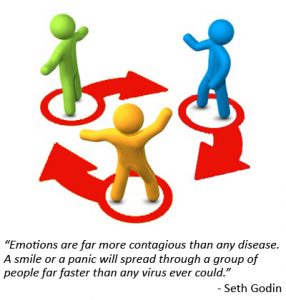By Ray Williams, February 18, 2019.

When you see someone coughing, you reflexively know to steer clear of his or her germs. When you observe someone who is cranky or complaining, it is less obvious what to do. We know that laughter is contagious. Or if you see someone crying you may find yourself tearing up too, even though you don’t have a reason to cry. Studies suggest, however, that others’ moods may be as easy to catch as their germs. Emotions can be catching. It’s called emotional contagion, and sharing emotions can happen easier than you may think.
And although study after study has demonstrated what a powerful impact Emotional Contagion can have on our relationships—domestic partnerships, friendships, teams, business relationships, and groups of all kinds—interestingly, we often don’t realize how much our own emotions are influenced by the emotional states of others.

What is Emotional Contagion?
Picking up someone else’s mood is known as Emotional Contagion (EC).Psychologists describe a three-step process through which one person’s feelings are copied by another person. The first stage involves unconscious mimicry, during which individuals subtly copy one another’s nonverbal cues such as posture, facial expressions and body movements. Let’s use the example of someone frowning. You frown and an emotion is triggered. This is the feedback stage–because you frowned, you now feel sad. During the final contagion stage, individuals share their experiences until their emotions and behaviors become synchronized. Thus, when you encounter a co-worker on a bad day, you may unknowingly pick up your colleague’s nonverbal behaviors and you begin to change into an unhappy state. This process of mimicry is not all bad, however; you can also adopt a friend or colleague’s good mood, which can help enhance your relationship.
Emotional contagionis facilitated by an interconnected network of cells in the brain that make up the Mirror Neuron System (MNS). The MNS is like a high-definition camera that observes and records every detail of people’s facial expressions, body language, pupil movements and even vocal tones. So if you’re with someone who is happy, and their happiness is written all over their face, your MNS will record their displays of happiness but it will also signal the same displays in you.
We know that happy people tend to smile a lot. In their presence, your MNS will record activity in the two major smile muscles: the ones that pull your lips upwards and the ones that crease the sides of your eyes. They will then signal your own smile muscles so that you will find yourself smiling more. But that’s not all that happens. The MNS also contains emotional areas of the brain. Some of these are signaled, too, helping to mirror, in you, the emotional state of the happy person.
John T. Cacioppo from the Center for Cognitive and Social Neuroscience at the University of Chicago explains that the more expressive someone is, the more likely you are to notice that expression and mimic it. He says “the muscle fibers in your face and body can be activated unbeknownst to you, at much lower levels than if you were to perform those movements yourself. It’s those muscle movements that trigger the actual feeling in the brain.”

The Research
In one study, marriage researchers Lisa A. Neff of the University of Texas at Austin and Benjamin R. Karney of the University of California, Los Angeles, examined more than 150 couples for three years to determine how one spouse’s stress influences the other spouse and overall marital quality. They found emotional crossover was more pronounced when the couple engaged in negative conflict-resolution practices, such as rejecting or criticizing the partner.
Researchers Nicholas Christakis and James discovered that happiness spreads through social networks, much like a virus, which means that you can be infected with the happiness of someone you’ve never even met, and vice versa. According to the authors, social networks have both clusters of happy people and unhappy people within them that extend to third degrees of separation. Christakis and Fowler say a person’s happiness is” related to the happiness of their friends, their friends’ friends and their friends’ friends’ friends—that is, to people well beyond their social horizon.” Their research found happy people tend to be located in the center of their social networks in large clusters of other happy people where each additional happy friend increases a person’s probability of being happy by about 10 percent.
However, negative EC is not isolated to our closest relationships according to Tony Schwartz, CEO of The Energy Project, and Harvard Business Reviewblogger, One bad (e.g., negative) apple can infect the entire tree regardless of where that tree is planted. Schwartz shared how this kind of unhealthy contagion spread quickly through his company after the hiring of a new executive.
According to researchers Elaine Hatfield and colleagues research which was published in their book Emotional Contagion, some people are more vulnerable to emotional contagion are individuals who tend to be particularly sensitive to the emotions of others, value interrelatedness over independence and uniqueness. Hatfield also believes that women tend to be more vulnerable to absorbing the stress and negativity of those around them because they are more often socialized to attend to the emotional needs of those around them and to want to please others than are men.
Researcher R. William Doherty concluded that susceptibility to emotional contagion is positively associated with affective orientation, emotionality, sensitivity to others, self-esteem, and more strongly associated with emotional than cognitive modes of empathy. Doherty also found in his research that introverts are “more likely to be affected by others’ positive emotions whereas those more oriented toward external, social reality tend to be more affected by others’ negative emotional expressions.”
One interesting study published in Clinical Psychological Science found that men’s smiles become more contagious as they consumed beer. The men who were served alcohol “caught” smiles more readily than those who did not consume any alcohol, but only in all-male groups. Alcohol in mixed groups and in all-female groups, on the other hand, didn’t make smiles any more contagious than non-alcoholic and placebo drinks.
Emotional contagion isn’t just linked to face-to-face interaction either, but can affect people on social media as well. When Facebook removed positive posts from the news feeds of more than 680,000 users, they made fewer positive posts and more negative ones. When negative posts were removed, the opposite occurred. “These results indicate that emotions expressed by others on Facebook influence our own emotions,” the authors wrote in a study published in the journal Proceedings of the National Academy of Sciences.
Studies also show that infants and children mirror the facial expressions of the primary caregiver, suggesting that they feel the same emotions, too, or at least their nervous system is reacting to the emotions of the caregiver.
Research has found that depression in a spouse frequently leads to depression in the partner. The same holds true for roommates. In addition, children raised by depressed parents are significantly more likely to be diagnosed with depression. In fact, one family member’s depression can bring down an entire family system. Other emotions, such as anxiety and fear, can have the same effect.
Sherrie Bourg Carter in her article in Psychology Today cites the work of Caroline Whang, who notes that workers who deal with trauma victims on a regular basis often experience serious physical and emotional symptoms such as muscle tension, fatigue, low energy, insomnia, and depression. Whang also describes a study of infants out of the National Jewish Medical and Research Center at the University of Colorado that found children whose parents are experiencing significant strain are more likely to develop asthma and autoantibodies that increase their risk for diabetes.
According to researchers Hatfield, Cacioppo, and Rapson, some people are more vulnerable to Emotional Contagion than others. They have found that those who are most vulnerable to “catching” others’ emotions are individuals who tend to be attentive and sensitive to the emotions of others. value interrelatedness over independence and uniqueness, and those whose conscious emotional experiences are heavily influenced by peripheral feedback.

Researchers suggest that prevalent moods in groups of adolescent friends are contagious. According to the latest data available to the National Institute of Mental Health, approximately 3 million adolescents aged between 12 and 17 in the United States had at least one major depressive event between 2014 and 2015. But although cases of diagnosed depression are reaching worrying numbers worldwide – the World Health Organization (WHO) estimate that around 300 million people are affected worldwide – many people, and especially adolescents, exhibit depressive symptoms that are just under the threshold for a clinical depression diagnosis. Now, researchers from the University of Warwick in Coventry, United Kingdom, are looking at how adolescents’ social circles can influence their moods, in an effort to better understand what determines depressive symptoms among teenagers and what might alleviate them.
Eyre and team note that existing studies have already started mapping a concept called “social contagion,” suggesting that our social environments impact our emotional profiles. Some research more specifically targeted teenagers, showing that adolescents with strong friendship groups tend to have better mental health. “Previous studies have found social support and befriending to be beneficial to mood disorders in adolescents,” Eyre points out, “while recent experiments suggest that an individual’s emotional state can be affected by exposure to the emotional expressions of social contacts.” And now, the research team has looked at whether or not a teenager’s friendship group can influence various mood changes, and how drastic these changes can be. “Clearly, a greater understanding of how changes in the mood of adolescents are affected by the mood of their friends would be beneficial in informing interventions tackling adolescent depression,” says Eyre.
What Can You Do?
Research from University of Oklahoma and University of Texas at Austin shows that when individuals dislike the same people or find a common dislike of something in general, all of a sudden those individuals have a bond that easily turns into a friendship because it’s a connection.
What’s the life lesson in this asks Jodi Shulz at Michigan State University? She recommends asking yourself:
- “What types of emotion do I give off and how does that affect others I interact with such as my family, roommates, team mates, colleagues, etc.?
- How easily do I let others effect my emotions? Do I even know it is happening? Check out the Emotional Contagion Scaleto see how vulnerable you are.
- Are the people in my social networks the type of people I really want to surround myself with?
- Are there actions or changes I need to make?”
Here are Some Suggestions on How to Deal with Negative Emotion Contagion
- Avoid people who can infect you with their negativity. If you can’t avoid them, take small min-breaks away from them and do something positive or happy.
- When you are around negative or toxic people, smile often, be happy and be positive as a much as you can, even if you have to act a little. Your positive emotions can be viral as well.
- If you have to deal with a habitual negative person, you may have to say something to them about their mood. Making an inquiry about what may be bothering them will show that you care, but also be honest about how it’s affecting you. Avoid blaming language.
- If you’re working on a team or in a meeting, control how much teams or meetings focus on the negative, complaining or criticisms. Share the good success stories and feedback, preferably first, before you examine what’s missing or problem solve.
- Take care of yourself. Much like a common cold or any other illness, if you’re tired, weak, or hungry, you’ll be even more vulnerable to catching someone’s negative emotions. Make sure you get enough sleep. Eat well, exercise, and make sure you get some sunshine. Exercise and sunshine stimulate the release of endorphins, our body’s own natural mood elevator.
- Don’t take responsibility for others’ negative moods. You can’t control how someone else feels even though you may feel empathy and compassion. You can only control how you feel. Merging with the other person is a sure recipe for unhappiness.
Summary
Emotional contagion has the power to be both good and bad. It’s a hard-wired trait that has been with the human species for a long time and has helped our ancestors understand each other before spoken language was developed. Moving forward, the best way to utilize the knowledge of emotional contagion is to surround yourself with happy or positive people if you want to feel happier and positive and avoid the people who are toxic or negative as much as possible.
Copyright: Neither this article or a portion thereof may be reproduced in any print or media format without the express permission of the author.
Read my latest books:
- Eye of the Storm: How Mindful Leaders Can Transform Chaotic Workplaces, available in paperback and Kindle on Amazon and Barnes & Noble in the U.S., Canada, Europe and Australia and Asia.
- I Know Myself and Neither Do You: Why Charisma, Confidence and Pedigree Won’t Take You Where You Want To Go, available in paperback and ebook on Amazon and Barnes & Noble in the U.S., Canada, Europe and Australia and Asia.


